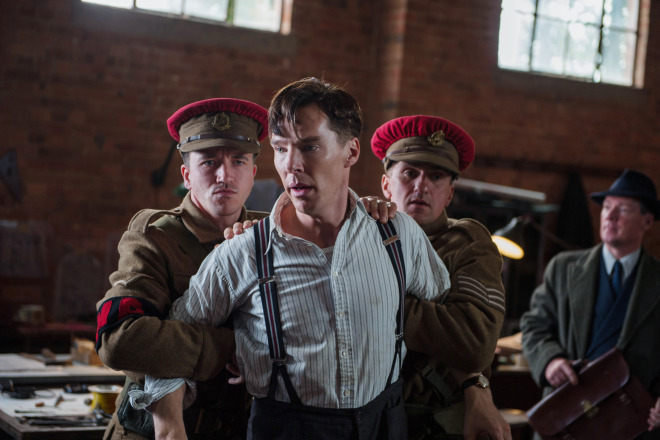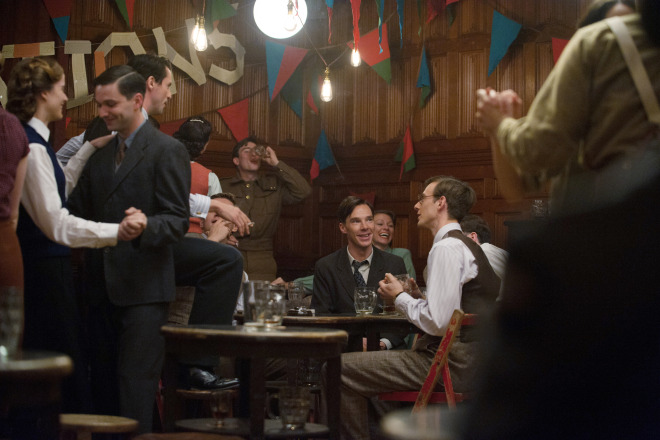
 Jack English/The Weinstein Company
Jack English/The Weinstein Company
Screenwriter Graham Moore is a self-described Alan Turing obsessive: He went to space camp and computer programming camp as a teenager, so the famed mathematician loomed large, “like a campfire legend or something.” Turing’s life ultimately proved so inspirational to Moore that bringing his story to the big screen became a life goal.
“Once I became a writer I would go to my agents once a year and say, ‘Hey, there’s this movie I really want to write about a gay English mathematician who commits suicide after the Second World War,'” Moore remembers. “And they were like, ‘That’s a big Hollywood movie!’ … No, they did not say that at all. They were like, ‘Please don’t ever write that; no one will ever finance that movie.'”
Nevertheless, when producers Nora Grossman and Ido Ostrowsky got the rights to Andrew Hodges’ Turing autobiography Alan Turing: The Enigma, Moore signed up to write the script—for free. And while he was writing, he was aware that he wanted the screenplay for The Imitation Game, which hits theaters today, to do Turing justice. “There’s this responsibility to do it properly and to do it with respect,” Moore says. “Historical accuracy was tremendously important to us.”
That accuracy wasn’t that easy to come by, however; most of the records of Turing’s work for British intelligence during World War II were destroyed. Following the war, nearly every trace of Bletchley Park’s day-to-day operations—where Turing (played by Benedict Cumberbatch in the film) and his fellow code-breakers were working on cracking Germany’s Enigma code—was either erased from history or kept extremely confidential. (It’s one of history’s awful ironies that the general public found out Turing was gay, by way of an indecency trial brought by British authorities, long before they found out he was largely responsible for outsmarting the Nazis.)
“Everybody at Bletchley kept the secret,” Moore notes. “Then, when Turing was on trial for indecency, he never raised his hand and said, ‘Oh, and by the way I’m a war hero.’ Instead what he did was raise his hand and say, ‘I’m not going to dispute the facts, but I’m still pleading not guilty because what I did should not be a crime.'”
Of the few other well-known things about Turing is how he died. On June 7, 1954, after undergoing “chemical castration” (estrogen injections) as a way of avoiding prison time for his indecency conviction, he was found dead in his apartment of cyanide poisoning, holding the apple he ate to ingest it. While Moore wrote that scene, and director Morten Tyldum filmed it, it didn’t make the final cut.
“We never wanted to see him commit suicide on screen,” Moore says. “This film was about paying attention to Alan Turing’s tremendous life and his amazing accomplishments. It felt to us more ethical and more responsible to focus on his life and his accomplishments than the nitty-gritty of his suicide.”
And that’s just one of many tough decisions, educated guesses, and historical excavations Moore had to make while penning his brilliant script. Here are a few other things you may not know about The Imitation Game.
Moore’s Script Is Actually a Puzzle the Audience Is Meant to Solve
One of the most interesting things about the movie is its structure: It jumps back and forth between Turing’s time at Bletchley, the final days before his death, and his childhood—when he met and fell in love with both Christopher Morcom and cryptography. The structure is meant to give a fuller picture of who Turing was and why he did the things he did—if you can piece it together. “Alan Turing was obsessed with codes and puzzles and games,” Moore says. “I wanted the whole movie to be an Imitation Game where the answer to the puzzle was Alan Turing’s mind.”
Turing’s Code-Breaking Machine Wasn’t Really Named ‘Christopher’
One of the more touching things in Imitation Game is the moment when Turing tells Joan Clarke that he’s named the computer he’s working on “Christopher” (after Turing’s first love—Joan doesn’t know that part, though). The real machine was called the Bombe (or “Victory”). “That was my invention,” Moore says. The idea is based on the belief held by Turing’s biographer Hodges and many other historians that Turing’s fascination with computers and artificial intelligence came from their friendship, which ended early when Morcom died at age 18 from tuberculosis. “Turing wrote extensively about whether or not this technology could be used to keep a person’s mind alive,” Moore says “I think his entire lifelong pursuit of artificial intelligence was all about bringing Christopher back. Naming the machine Christopher was a dramatic way for us to show that very real lifelong obsession.”

 Jack English/The Weinstein Company
Jack English/The Weinstein Company
The Only Scenes Actually Shot at Bletchley Park Happened at the Pub
Nearly a third of The Imitation Game takes place at the decryption facility at Bletchley Park, where Turing, Joan Clarke (Keira Knightly), and their fellow code-breakers worked tirelessly to decipher the German military’s Enigma code. Most of the scenes set at Bletchley were shot on soundstages—and surprisingly, the ones that weren’t were the ones filmed at the bar where Turing and his colleagues drank and socialized. “The beer hut was one of the most difficult locations, we struggled with that. And that’s the one we ended up shooting in Bletchley Park,” says production designer Maria Djurkovic. “We felt it was right to shoot something there.”
Parts Were Also Filmed at Turing’s Childhood School—Where His Picture Is Still on the Wall
Like many boys in Britain in the early 20th century, Turing went to boarding school, and the scenes from his days at Sherborne School were shot on location, a place that haunted Moore just a little bit. “You’re walking down the halls and you see all the class portraits of the kids going back to the 1920s and you see Alan Turing and you see Christopher Morcom,” he says. “I remember looking at that and being very spooked.”
One of Moore’s Best Sources Was James Bond Writer Ian Fleming
Since so much of Turing’s work with British intelligence and MI6 was kept secret, Moore went hunting for details about what Turing did and what influence he had in the organization—with some surprising results. “The best evidence we have as to Alan Turing’s work with MI6 after they’d broken the code actually comes from the diary of Ian Fleming, which is so bizarre,” Moore says.
Some of the Characters in The Imitation Game Are Actually Based on More Than One Person
“The goal was to tell Alan’s story fairly and responsibly and accurately,” Moore says. “That meant that we sometimes had to dramatize things—or to take things that happened over a period of months and make them into a scene.” That also meant that multiple people, and the things they did, were condensed into a single person. “For example, the character that is called Hugh Alexander, who is played by Matthew Goode, he’s a character that is half Hugh Alexander and half Gordon Welchman, another mathematician on the team,” he says “We had to sort of use little tricks like that. But every major event in the film did occur.”
The Police Officer Who Interrogates Turing Is the Only Character with a Fake Name
Nock (Rory Kinnear), the officer who questions Turing in the film, isn’t entirely real. Rather, Moore says, he’s meant to symbolize “the institutionalized homophobia of the day, to show that this wasn’t some raving lunatic who arrested in persecuted Alan Turing.” And, to protect the cop who did interrogate the computer scientist, Moore changed his name. “I made that decision very early on because the real police officer didn’t die all that long ago and he still has family who are alive and I did not want to implicate the real person in that,” he says.
The Movie Almost Had a Reference to the Urban Legend That the Apple Logo Is Based on Turing’s Death
For years computer science circles have hummed with speculation that the bitten-apple logo on Mac products was a reference to Turing’s death. It’s such an interesting tidbit the filmmakers almost mentioned it in the movie. “We debated putting that in text at the end of the film; that was a lively debate for many months,” Moore says. “The debate was that this was this amazing story that there was this rumor and that Steve Jobs had publicly denied it many times but other people seemed to think it was true. … We would’ve loved for it to be true. But we didn’t have enough evidence to feel comfortable putting that in as text. Personally, I think it might be true, but because we couldn’t prove it, it was ethically tricky.”